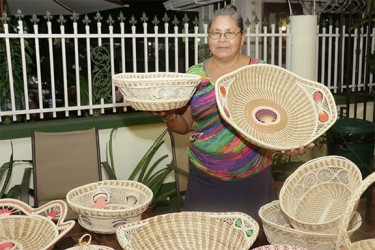We met Janet Patterson in the foyer of the Sleep Inn International Hotel on Brickdam last Friday evening. People were coming and going; visiting guests ‘soaking up’ what little was left of the seasonal revelry. Patterson was tending her display dutifully, hoping that the indigenous craft would capture their attention.
When asked, she said that the items of craft she was displaying had been made by residents of Santa Mission. Among people who know, Santa Mission has earned a reputation for producing the highest quality indigenous craft. The evidence on Patterson’s display appeared to make a case for the truth of that assertion.
Patterson is a frequent visitor to the city. Every two weeks or so, she makes the journey from Santa Mission along the winding Kamuni Creek and across the Demerara River. The boat in which she travels is laden with craft. Her task is find markets for what she brings to the city.

There is something about the arrangement that resembles an old-fashioned cooperative. The craft is made and handed over to Patterson, who accepts the pieces on consignment and pays the makers when they are sold. On this trip she has brought craft made by 25 different craftspeople, who hope that their handiwork will sell well.
The cost associated with marketing the craft in the city is frequently met, in the first instance, by Patterson. She recoups that cost out of the sales. A round trip could cost as much as $25,000. That does not include the cost of her stay at Vergenogen which can last for as two days.
Patterson’s pursuit is a bold and risky initiative. It arises out of the absence of a lucrative market at the Mission. The alternative is that the craft makers must depend on visitors to Santa Mission, most of who are on their way to or from the Roraima Airways-owned Arrow Point Nature Resort.
Over time, Patterson has developed a rapport with the management of the Sleep Inn International and another facility in Georgetown which she declined to name. There is no cost to the display space she is afforded.
These are simply gestures by urban businesses that subscribe to the view that the local craft industry is worth supporting. It’s difficult to resist the view that this is a gesture that other suitably-appointed urban businesses might wish to emulate.
Patterson herself has been in the business of making and marketing craft for more than 20 years. Like most of the other families at Santa Mission it is an important means of livelihood. Between her commercial pursuits and her husband’s work in the logging industry, she has raised seven children.
Three are graduates of the University of Guyana and now work in the local teaching, forestry and engineering sectors. A fourth child is currently completing studies at UG.
Evidently proud of her children, Patterson believes she has become something of a role model for the women of the community. Her efforts in support of their entrepreneurial pursuits are driven largely by the fact that the returns from the sale of their craft help to meet the costs associated with educating some of the children of Santa Mission in Georgetown.
Patterson said she will continue to target other suitably appointed businesses that would allow her to market the craft. She targets visitors to Guyana. A point has not yet been reached, she said, where local patronage can sustain the industry.
She conceded that pricing has been an issue though she explained that there is perhaps insufficient appreciation of the process involved in creating the items. The people of Santa Mission specialise in the creation of craft made from Tibisiri. The leaf must be harvested, stripped, boiled then dried. Only then can the trained hands of the craftspeople be applied in the creation of the various items.
On Friday evening the Tibisiri offerings from Santa Mission included decorative bread boxes, fruit baskets, jewellery holders, table mats and traditional Amerindian arrows and bows.
The neatness of the finished product is complimented by tasteful labels which Patterson believes embellishes the product. Each item bears a description, the material from which it is made and the price in local and United States dollars.
She conceded that in some instances prices are “hot”. The items on display on Friday, ranged in price from US$20 to US$90. Asked whether she felt local consumers were favouring cheaper imports over Amerindian craft she simply smiled her agreement.
It was early evening when we began our interview with Patterson and she had no more than two or three hours before she would have to dismantle her display. She confided that she had not made a single sale for her current trip to the city.
During the interview, she intermittently responded to telephone enquiries from Santa Mission about the trading day. She revealed that she would have to return to Santa Mission the following day around $20,000 out of pocket. That becomes a shared loss. It is an occupational hazard of the trade.





